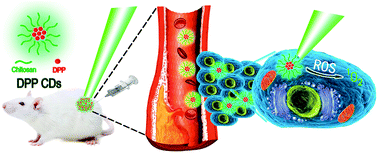Diketopyrrolopyrrole-based carbon dots for photodynamic therapy†
Abstract
The development of a simple and straightforward strategy to synthesize multifunctional carbon dots for photodynamic therapy (PDT) has been an emerging focus. In this work, diketopyrrolopyrrole-based fluorescent carbon dots (DPP CDs) were designed and synthesized through a facile one-pot hydrothermal method by using diketopyrrolopyrrole (DPP) and chitosan (CTS) as raw materials. DPP CDs not only maintained the ability of DPP to generate singlet oxygen (1O2) but also have excellent hydrophilic properties and outstanding biocompatibility. In vitro and in vivo experiments demonstrated that DPP CDs greatly inhibited the growth of tumor cells under laser irradiation (540 nm). This study highlights the potential of the rational design of CDs for efficient cancer therapy.



 Please wait while we load your content...
Please wait while we load your content...